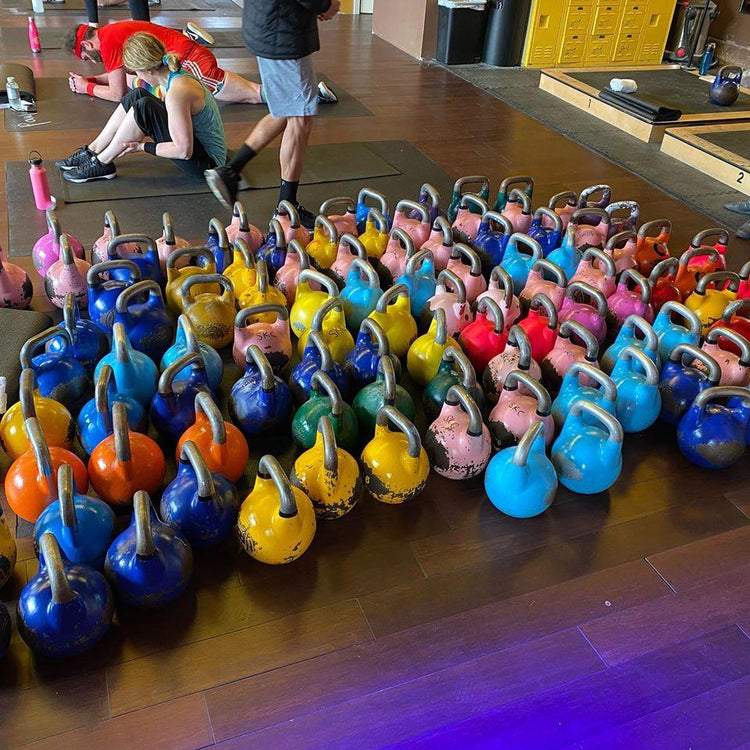Removing Rust from Kettlebell Handles

Kettlebells typically contain iron and therefore are highly susceptible to rust.
High humidity or sweat left from your hands will reveal burnt umber specks clinging to the surface of your beloved kettlebell within days.
Although a wise man once told me... Just like a rolling stone gathers no moss, a used kettlebell gathers no rust.
But (in my opinion) a handle that can't rust isn't worth using.
If it can't rust, it's likely either powder coated, plastic, rubber or has some sort of protective clear coat on it.
Here are the main problems you'll find with these coatings:
- Problem #1: The Handle is Too Slick
- Problem #2: The Handle Has Too Much Stick
- Problem #3: The Handle Won't Hold Chalk
Why Your Kettlebell Handle Matters
To get the most out of training with kettlebells, you'll want to be using your kettlebell for exercises that take advantage of its unique properties.
Sure, you can (and should) use kettlebells to add kettlebell deadlifts into your routine, but it's possible to accomplish similar benefits with barbell deadlifts.
What makes a kettlebell exercise a true kettlebell exercise is when it is something that can best be done only with a kettlebell.
Those moves, like the kettlebell swing, clean, and snatch to name a few, involve the handle of the kettlebell moving quickly and repeatedly in your hand.
If a handle is too slick, you'll have to grip it tightly to keep from dropping it during swinging movements, which will fatigue your forearm quickly and you'll have to stop prematurely.
If a handle is too sticky, or has too much "grab," it will create unnecessary friction and you can quickly develop calluses or tear your hands.
If a handle can't hold chalk, you're stuck with the condition of the handle as it came.
Let me explain.
Even a raw metal handle can be too slick or have too much "grab" depending on the surface finish, weather conditions, and even the amount of sweat you produce, which is why professional and serious hobbyist kettlebell users put chalk on their handles.
According to the lifter's taste, they'll apply thin or thick coatings of chalk to the handle to provide just the right amount of "slip and grip" to be able to hold on to the kettlebell when they're fatigued, but not so sticky that it grabs the skin and creates or rips their calluses. If a handle has a slick texture and the lifter sweats a lot, they're probably going to apply a fairly thick coating of chalk to build up texture and absorb their sweat.

Pro Kettlebell with Chalked Handle
What Does "Stripping Your Kettlebell Handles" Mean?
So, the first thing a true kettlebell lifter does when they receive a new competition style kettlebell is to use a product like citristrip to remove the clear coating from the handle. (We're not marketing for citristrip, it's just a great product.)
Once the kettlebell handle is bare, test it out and see if it can slide freely in your hand. If it doesn't, or if you're preparing to do a monster workout or kettlebell sport (endurance) training set, then you'd want to prepare the handle with chalk.
On this note, we've stripped thousands of kettlebell handles, and found the process costly, messy, and time-consuming, which is why when creating the Pro Kettlebell, we opted to keep the handles bare for our customers.
This poses the challenge of users having to keep the handles from rusting, but we believe it's worth it to save the customer the hassle of doing something they may not even know they needed to do to get the best result from their new equipment.
Not to mention being able to pull your kettlebell out of the box and feel that silky iron texture in your hand, ready to chalk up or get swinging, is pretty cool for the kettlebell lifters out there who know the hassle of stripping.
How to Keep Your Bare Handles from Rusting
-
Wipe dry with a towel after your workout
-
Store indoors
If you aren't able to do those things (or if you are but rust is appearing anyhow), here are a few other tips to try:
-
Store in a rubber tote
-
Store in a dry sack
-
Store in a bag with a moisture absorber
Wrap a hand towel snuggly around the handle when not in use
How to Clean Off the Rust from Your Kettlebell Handle
Now that you understand why the bare handle is preferred, hopefully you'll find the maintenance of removing rust occasionally rewarding, like washing your car or seeing the lines in a freshly vacuumed carpet.
The most accessible method of removing rust off of your kettlebell handle is the one pictured here.

-
Cut a strip from a sheet of sandpaper or get sandpaper that is for a belt tool and wrap it all the way around the handle.
-
Pull back and forth, sanding off the rust (this works to remove old chalk, too).
-
When you've got as much off as you can with the sandpaper, get a magic eraser damp and use it to clean off the remaining particles.
Wipe dry with a cloth and enjoy.
If there's not much rust to begin with, you may be able to skip the sandpaper and just use a magic eraser.
Other Methods for Removing Rust
Our other favorite methods for removing rust on light or thick accumulations of rust on your kettlebells are:
- Scotch Brite Pads
- Bar Keepers Friend You can apply it with a wet sponge or rag. Use steel wool or a sponge and some elbow grease and your handle will sparkle.
In the video above, for our first step to removing rust, we wrapped the kettlebell handle in a washcloth soaked with CLR for about ten minutes before proceeding with the Bar Keepers Friend scrub.
Got hand tools? Removing rust is fast! Try:
Hand-held mini-belt sander
Wire wheel attachment for a drill or angle grinder
Don't forget to wear safety goggles and a dust mask!

Get Your Hands on a Pro Kettlebell Handle
In summary,
-
For best performance, strip protective coatings from your kettlebell handles when you receive them (not necessary for Pro Kettlebells, which come bare)
-
Keep handles dry and temperature controlled to prevent rust from forming
- Removing rust is achievable through a variety of methods
Want to feel a great handle for yourself? Check out our Pro Kettlebell online shop.







